
Click play below to hear how to help students become independent:
Even though you’re almost three-quarters of the way done with school, it doesn’t mean you can’t teach your students new skills or try new things in your classroom. One thing you’ve probably been doing all year is pulling small groups. And even though you’ve done this all year, it’s still important to implement new strategies or have your students work on new skills. I get a lot of questions involving small groups, and an underrated skill students need is independence. So in today’s episode, I’m sharing four steps in helping your students become independent when pulling small groups.
Most questions I receive regarding small groups have to do with what to do with the students not in the small group. How do I keep them engaged and with what activities? An important aspect of these questions has to do with helping students become independent. Although gaining independence takes time and is a process, each of my four steps are things you can do daily, weekly, or monthly, with the key of keeping it consistent. Whether my ideas ask you to define your expectations, monitor the stamina of your students, practice, or reflect, they all lead to your students’ independence.
Small groups are great to prepare for test prep season, which is inevitably upon us. So with this increased activity happening in your class, it’s important for your students to be engaged in independent work. And by consistently implementing these four steps, you will have your students become independent in no time!
In this episode on helping students become independent, I share:
- 4 steps that will help your students become independent, especially when pulling small groups
- A reminder that gaining independence takes time and is a process for students
- Why you need to set clear expectations during small groups and questions to ask yourself to make sure you’re covering all areas
- How to model independence with the help of your students
Resources:
- Sign up for my Private Podcast: Confident Writer Systems Series
- Check out the Stellar Literacy Collective Membership
- If you’re enjoying this podcast, please leave a review on Apple Podcasts!
Related episodes and blog posts:
- Episode 151, 5 Myths About Small Group Instruction (And What to Believe Instead)
- Episode 140, Top 5 Aspects of Small Group Instruction to Plan for NOW!
- Episode 114, Seasonal Spotlight: Five Tips for Returning To Independent Reading After Winter Break
- Episode 91, Answering Your FAQs About Small Group Instruction
- Episode 89, Setting Up Your Classroom for Small Group Success
Connect with me:
- Join my newsletter
- Shop my TPT store here
- Instagram: @thestellarteachercompany
- Facebook: The Stellar Teacher Company
More About Stellar Teacher Podcast:
Welcome to the Stellar Teacher Podcast! We believe teaching literacy is a skill. It takes a lot of time, practice, and effort to be good at it. This podcast will show you how to level up your literacy instruction and make a massive impact on your students, all while having a little fun!
Your host, Sara Marye, is a literacy specialist passionate about helping elementary teachers around the world pass on their love of reading to their students. She has over a decade of experience working as a classroom teacher and school administrator. Sara has made it her mission to create high-quality, no-fluff resources and lesson ideas that are both meaningful and engaging for young readers.
Each week, Sara and her guests will share their knowledge, tips, and tricks so that you can feel confident in your ability to transform your students into life-long readers.
Tune in on your favorite podcast platform: Apple, Google, Amazon, Spotify, Castbox, and more! If you’re loving this podcast, please rate, review, and follow!
Podcast (stellar-teacher-podcast): Play in new window | Download
Hey, there, happy Monday. Thank you so much for tuning in today, I always love when we get to connect through these podcast episodes.
So it is the beginning of March. And if I had to guess, if I took a peek inside your classroom, I bet you’re starting to have some students who are just kind of getting over school. In fact, maybe you’re over school, you know, we are well over halfway into the year. And things that were smooth and you know, seamless at the start of the year, or maybe becoming a little rocky, things that were exciting, are a little less shiny, and we’re just kind of in that season of the year where we just have to get through it.
And on top of all of that you guys are probably starting to think about the end of year tests. So you’re probably starting to have some disruption in your schedule. So one of the things that I know to be true is that in order for our instruction to be effective, we have to have our students be independent with their independent work. And I think this is especially true when we are pulling small groups, we frequently get asked questions just about everything literacy instruction in general.
But one of the most common questions we get asked is how do I get my students to become independent? How do I keep them engaged? How do I keep them busy, so I can pull small groups? And I know that when I started, you know when I was in the classroom, and of course, the closer we got to test prep season, the more frequent we pulled small groups, because not every student needed the same thing. So I was pulling more small groups, which means my students needed to be more independent than they had ever been before.
But that can be hard to do in the middle of the year. So what I would like to share with you today are four steps that you can take and put in place that are going to help your students become independent, while you pull small groups, whether it is small groups for your typical reading groups, or if it’s small groups for test prep, or in any subject, these four steps are totally going to work.
And before I jump into those steps, though, I just want to remind you that building independence takes time. And it’s a process. So these four steps are things that you’re probably going to have to repeat, you know, every day, every week, every month until the end of the year, because you know, independence is really a habit that we want to instill in our students.
So it’s not like we can just do these four things once and then assume that it is going to fix all of our problems. So just take these things and put them in place on a consistent basis throughout the end of the year, and you will increase your students independence.
So the first thing that you want to do is get really crystal clear on your expectations for this time. So if you are pulling small groups, and the rest of your class is working independently, or if they’re working in partners, or if they’re in literacy workstations, you need to get really crystal clear on your expectations for them.
I think a lot of times in our heads, we know exactly what we want this time to look like. And we have a very clear vision of how we want our students to be operating and participating. But we fail to communicate the very small details to them of that time.
So you want to set really clear expectations around things like movement, like are your students allowed to get out of their desks? Are they allowed to go sharpen a pencil? You know, can they return a book to the library? Can they go get scratch paper? What is the movement? You want to set expectations around the volume levels. Is it supposed to be completely silent? Can they be whispering? You know, if they’re talking in partners, what does that volume level supposed to look like?
Setting expectations for the materials, you know, thinking about what materials are your students going to need to be successful independently? Do they know all of the materials that they have to have? And have they been able to collect them ahead of time? Or are you confident that they have all of those materials at their desks?
Other things that we want to set expectations for are what happens if you have students who finish early? So you give them an assignment, you give them a workstation to participate in whatever it is what happens for the students that finish early? Do they know exactly what it is that they are supposed to do? And on the flip side, you know what is the expectation for students who don’t finish their work?
I know that I always had students that were very thorough and you know it took them a longer time to finish. But it created a sense of panic for them because they were worried they weren’t going to have enough time to finish. And then that caused just this mental distraction, and they weren’t able to be successful with their tasks. So alleviate that sort of mental hurdle for them ahead of time and let them know what is the plan if you don’t finish your work.
And then I think a really important thing to set expectations around is what happens if your students have a question? Can they ask a classmate? Can they ask you? Are there allowed to be disruptions? Should they write it down somewhere? You know, making sure that your students really understand everything. So movement volume levels, materials, early finishers did not finish what happens if they have a question.
And I think it’s really important to not only communicate these verbally to your students, but have these expectations clearly displayed somewhere in your class. And whether it is creating a Google slide that has all of these categories and the expectations or creating an anchor chart or a poster.
And one of the things that I liked to do when I was in the classroom is label each of these. So one movement, two volume levels, three materials, because inevitably, especially when you first get started, you’re going to have some students who are going to not meet your expectations. And rather than explaining what they’re supposed to be doing, you can just say that student’s name with the number.
And that way they are quickly reminded of it’s like, okay, that’s right, my volume level is not appropriate right now. Or I had a question and I wasn’t supposed to ask that. So you can very quickly get them on task without having to sort of break down what it is that they’re doing incorrectly.
So the first thing you’re going to do get really clear on expectations. And these are things even though you go through them in depth and set them once, revisit them time and time again. So that way, they just become ingrained with your students. So that is going to help your students build independence.
The second thing that you want to do is monitor your students independence stamina, really, no matter what it is that you’re working on. And I think oftentimes in literacy, we think of stamina when it comes to students independent reading, like, how many minutes can they read independently, but really, our students stamina just refers to how long can they work independently, while staying engaged and on task.
And you know, as the year goes on, our students are probably going to lose some maybe internal motivation or some drive, you know, everybody just gets tired as the year goes on. And so we want to make sure that we’re monitoring our stamina. And ultimately, we want to set our students up for success.
And so if we are you pulling small groups, and maybe you do two small groups at a time, so your students are working for, you know, 40 minutes independently, and even if they’re switching tasks, it’s 40 minutes. So pay attention, you know, are the majority of your students engaged? Are they completing their tasks? Are they able to be successful?
And if they aren’t, then you want to do some things that will set them up to be successful. Again, remember, we always want to try to create a structure and a routine and a rhythm that will allow our students to be successful.
So maybe, you know, if you’re pulling in small groups, rather than doing two 20 minute small groups back to back, maybe you split them up. So students only have to work for 20 minutes at a time independently. You know, maybe if you notice your students are disengaged with whatever task you’ve been giving them, maybe it’s time to introduce something new.
So if you’ve been doing literacy workstations, then maybe it’s time to introduce some new workstations, and let your students you know, engage in something that is slightly different than what they were doing. If you were doing independent reading, maybe it’s time to pause that for a little bit and bring in some different activities, or let your students do some partner practice so that way they’re participating in a task.
But with a partner, collaborative learning is always a win for our students. You know, if you’re giving your students teacher assigned tasks, again, maybe it’s time to break up the tasks make them a little bit shorter, making it easier for our students to be successful.
So we want to really monitor our students stamina, and if they’re able to be engaged or not, I always think our students are going to give us clues about how we need to really just adjust our instruction. So again, if your students are doing just fine with the length of time that they are working independently, then keep moving ahead. But if you’re starting to notice that your students are running out of steam, and it’s hard for them to stay focused, then put some things in place.
You could also put some, you know, whether it’s like a little brain break or something in between, maybe if it’s just every, you know, 10-15 minutes, something like that. I always think our students are very, I don’t wanna say trainable, because that makes it sound like we’re training a dog or something, but they thrive off of routine.
So even if you’re pulling in small group, you could easily set a timer that goes off, you know, every 10 minutes, and there’s just a visual display on your smart board. And it’s a cue for your students to get up stretch. They could do all of that silently if you teach them how and practice it while you’re supporting a small group.
So just thinking about, you know, we need to monitor our students stamina, and make sure that the amount of time that we are asking them to be independent is something that they can experience success with. And if it isn’t, then we need to make some adjustments so that way, we are setting them up to be successful during our independent practice.
Okay, the third thing that you need to do is you need to practice even in March, we need to practice how to be independent. And this isn’t something that you necessarily have to do every single day. But this could be something that you do once a week, maybe this is something that you do every other week, maybe this is something that you do at the beginning of your week, during your morning meeting, whatever it is, we want to practice, though.
And when we’re practicing, what we want to do is basically not only review our expectations, but show our students what that actually looks like in practice. So you can of course, model the right way to do whatever the expected task is, model the wrong way to do it. Students always love doing this.
So rather than you being the one to model, you could have a student to show them, you know, it’s like, okay, we’re going to just quickly review our expectations for independent reading, who can show us the right way, who can show us the wrong way, that’s going to take just a few minutes at the start of your literacy block and could make such a huge difference.
You know, have students practice several times before they’re expected to complete the task independently. So again, if you’re introducing something new, or if you’re just coming off a week long break, it might be helpful to have your students work in partners, or to do something whole group before we have students do it independently, just so that way, they are very confident, and how to do something, so they can be successful.
And then one of my favorite ways to practice is to do a what I like to call a fishbowl example. And with a fishbowl, what you’re going to do is you’re going to pick a small group of students, and they’re actually going to go through the motions. So maybe you’re introducing a new literacy workstation, or maybe you’re getting started with test prep practice for the first time, and you want to show your students what that looks like.
So you’re going to hand select maybe five students who you know, are going to do things correctly, you have students in your class who I know, he’s like, Okay, if I call him them, they’re going to do exactly what I want them to do. So they’re gonna go through the motions, while the rest of the class is, you know, sitting on the carpet or at their desks, and they’re watching these five students.
And as these five students are going through the motions of doing the work, you’re gonna provide a narrative, and you’re gonna point out what they’re doing. It’s like, Okay, notice how so and so went to their desk, and they got started right away, notice how so and so got all of their materials out before they got started. Notice how this, you know, so you’re pointing out the things that you want your students to pay attention to, but they’re seeing other students do it.
And that can be such a great way to practice, that could be something again, all of these things could be done at the start of your week. One time, just to quickly review, I think we have to remind ourselves that we want to constantly have our students practice the right way to do things. So that way, it is ingrained in them. And it definitely becomes much more of a habit.
And then the final thing that you can do, which I think is something that you can probably do every single day, and can be so helpful is at the end of your independent work time, so whether it’s for small groups, or like test prep, or even if it’s an another subject, take some time to reflect and provide feedback. If you are really struggling to get your students to be independent, then you need to be giving them feedback on what they are doing well, and feedback on what they could improve upon.
So including a reflection session can be very helpful. And this could be something that could just take two to three minutes at the end of your independent practice time. And these questions could be discussed whole group, these are questions that you could have students write down on a sticky note. So they all independently have to reflect and then you could discuss them whole group, you could ask a different question every single day.
But things that you want them to think about are to identify what went well, but then have them explain why I always love to follow up with a why. So it’s not only are we saying, you know, I was on task today, okay, why were you on task, because if they can identify the why, whether it is I knew exactly what I was supposed to do. I was confident in this subject, I had all of my materials, whatever the why is, it’s going to help them recognize what they need to be successful.
So what went well, today? Why? But then we also want students to think about what didn’t go well, and why. And I always think this is a good question to challenge your students to answer, even if you know, things, for the most part went really, really well. You know, having them really reflect and think about okay, is there something that could have gone better? Was there one small thing you know, even if it was like a confidence issue, or an understanding issue, having them just be really self aware, I think can be so important.
So having them think about what didn’t go well? And why? And then probably the best question for everybody to answer is what can we improve upon next time? And I really love focusing on the we, because I think it helps students recognize that this is not one individual student’s responsibility, but everybody is responsible for contributing to a work environment.
So just make sure that at the end of your independent practice, you take time to reflect and give feedback and really get students input. Things that they could do are as they write their answers to these questions down they could already set a goal for the next day that you could then review at the beginning of your independent practice time.
So four steps that you can put in place that are going to help your students build independence are one get really clear on your expectations for your independent practice time. The second thing is for you to monitor your students stamina. And if you’re noticing that they’re running out of steam, then make some adjustments.
The third thing is to practice and even though they are doing independent practice every day, we want to spend just a few minutes practicing and talking about those expectations and what they look like. And then the fourth thing, which maybe is the most important is to consistently reflect and provide feedback. So making sure that we’re giving our students an opportunity to really think about their contribution to the independent practice time of the day, and what went well, what didn’t go well, and what they can improve.
And remember, all four of these things are things that you’re going to constantly want to come back to and put in place throughout the rest of this year. Because building independence, it takes time. It’s a habit that we want to build within our students. And so we need to make sure that we’re constantly coming back to these four things. So that way our students can become more independent.
So I hope you start to put these things in place this week, and I hope that you start to notice an increase in your students independence throughout the rest of this year. Have a stellar week, and I will see you back here next Monday.








Leave a Comment
You must be logged in to post a comment.